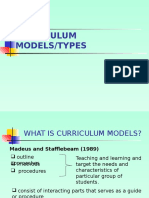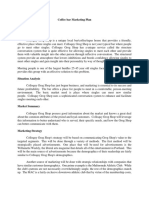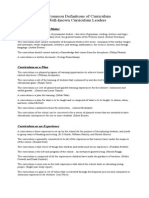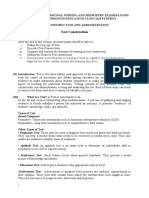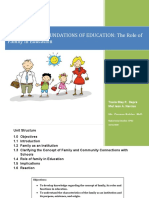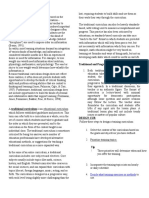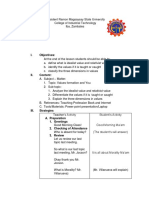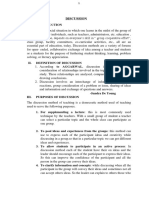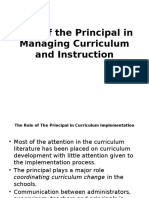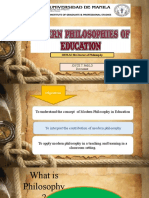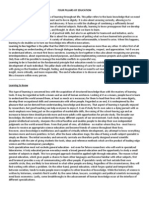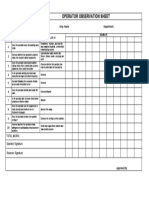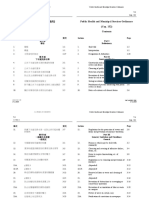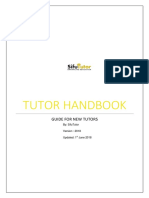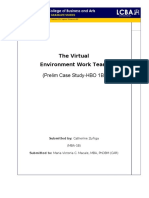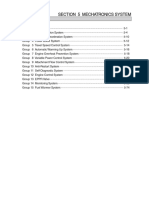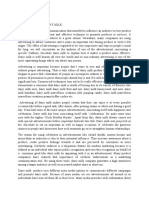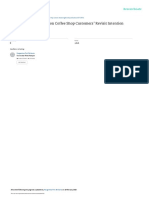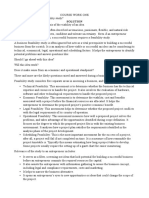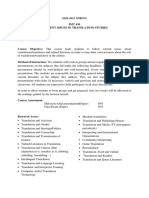Humanism Learning Theory
Humanism Learning Theory
Uploaded by
Edy UtCopyright:
Available Formats
Humanism Learning Theory
Humanism Learning Theory
Uploaded by
Edy UtCopyright
Available Formats
Share this document
Did you find this document useful?
Is this content inappropriate?
Copyright:
Available Formats
Humanism Learning Theory
Humanism Learning Theory
Uploaded by
Edy UtCopyright:
Available Formats
Humanism Learning Theory
Learning goal is to humanize humans. Will succeed if the student has to understand the environment and himself. This theory seeks to understand learning behavior from the viewpoint of the perpetrator, not from the perspective of her observations. The main goal of educators is to help the students to develop themselves, which helps individuals to recognize themselves as unique human beings and help in realizing the potentials that exist in them. The characters in the theory of humanism is 1. Arthur Combs (1912 - 1399) Learning occurs when a means for individuals, teachers can not impose material that does not like or are not relevant to their lives. 2. Abraham Maslow Maslow's theory is based on the assumption that individual within one of two things: 1. A positive effort to develop, 2. Strength to resist 3. Carl Rogers Rogers distinguished two types of learning namely: 1. Cognitive (significance), 2. Experiential (or significant experience), students' personal involvement, initiative, an evaluation by the students themselves, and there is a lasting effect on students. One of the open education model involves the concept of facilitative teaching and teacher who developed Rogers studied by Aspy and Roebuck in 1975 about the ability of teachers to create conditions that support the empathy, appreciation and positive feedback. The characteristics of a facilitative teacher is: 1. Responding to students' feelings 2. Using the ideas of students to carry out the interactions that have been designed 3. Dialogue and discussion with students 4. Respecting students 5. Correspondence between attitudes and actions 6. Customizing the content frame of mind of students (explanation to establish immediate needs of students) 7. Smiled at the students. Humanism theory Application of Student Learning The role of teachers in humanistic learning is to become a facilitator for the students while the teacher provides motivation, awareness of the meaning of learning in the lives of students. Teachers facilitate the learning experience to students and assist students to obtain learning goals. Students act as the main actors (student center) which defines the process of their own learning experience. It is expected that students understand the potential of themselves, develop themselves in a positive potential and minimize potential negative. The purpose of learning more to the process of learning rather than learning outcomes. The process is generally passed are: Excess Humanism Learning Theory 1. This theory is suitable to be applied in the learning material that is the formation of personality, conscience, change attitudes, and analysis of social phenomena. 2. Indicators of success of this application is the students feel happy excited, took the initiative in learning and change thought patterns, behaviors and attitudes of their own accord. 3. Students are expected to become a free man, not bound by the opinions of others and his own personal set in a responsible manner without compromising the rights of others or violate the rules, norms, disciplines or ethics. Lack of Humanism Learning Theory 1. Students who do not want to understand the potential for him will be left behind in the learning process. 2. Students who are inactive and lazy to learn to be self-defeating in the process of learning.
Constructivism Learning Theory
Constructivism theory is the learning that is generative, is actions create something of meaning from what is learned. One theory or well-known views related to learning theory of constructivism is Piaget's theory of mental development which is part of the cognitive theory as well. Piaget's theory of constructivism asserts that the emphasis on the process to find a theory or knowledge that is built from the ground realities. The role of teachers in learning according to the theory of constructivism is as a facilitator or moderator. The view of children from among the more recent constructivist developed from Piaget's cognitive learning theory states that knowledge is built in the mind of a child with the activities of assimilation and accommodation in accordance with the schemata they have. Unlike the cognitive style of Piaget's constructivism, social constructivism developed by Vigotsky is that learning for children is done in interaction with social and physical environment. that learning refers to learning theory of constructivism is more focused on student success in organizing their experiences. Non compliance of students in reflection on what has been ordered and carried out by teachers.
Behaviorism Learning Theory
Behaviorism theory is a theory which applies the principle of stimulus-response reinforcement. The point is that knowledge is formed through a stimulus-response bond is stronger when given reinforcement. Reinforcement was divided into positive reinforcement and negative reinforcement. Positive reinforcement as a stimulus, can increase the occurrence of repetitive behavior that. While negative reinforcement can lead to behavior is reduced or disappears. Figure of Behaviorism, 1. Edward Edward Lee Thorndike 2. Ivan Petrovich Palvov 3. Burrhus Frederic Skinner 4. Robert Gagne 5. Elbert Bandura Application Theory Teachers prepare lesson material in a form that is ready so that the learning objectives students must master delivered in full by the teacher. Teachers do not much give a lecture, but the instructions are followed by brief examples of well done alone or through simulation. Hierarchically arranged learning materials from the simple to the complex. Learning objectives divided into small sections which are marked by the achievement of a particular skill. Results-oriented learning that can be measured and observed. Errors must be corrected immediately. Repetition and practice are used so that the desired behavior can become a habit. Deficiency 1. A consequence for teachers, to prepare teaching materials in a form that is ready 2. Not every subject can use this method 3. Behaviorism the wrong application of the theory in a learning situation also resulted in the learning process is very unpleasant for students of the teacher as central, being authoritarian, oneway ongoing communication, teacher training and determine what students learned. 4. Pupils act as a listener in the process of learning and memorizing what is heard and seen as an effective way of learning 5. The use of punishment which is avoided by the Behaviorism figure that is regarded as the most effective method to curb student 6. Pupils deemed passive, need motivation from the outside and is strongly influenced by the reinforcement provided by teachers. Excess 1. Accustom teachers to be observant and sensitive to the situation and learning conditions 2. Behaviorism method is very suitable to acquire capabilities that need practice and conditioning that contain elements such as: speed, spontaneity, flexibility, reflection, durability, and so forth. 3. Teachers do not much give a lecture so that students accustomed to independent learning. If you find a new difficulty to the teacher in question asked 4. This theory is suitable to be applied to train the children who still need a dominance of adult roles, like to repeat and should be socialized, imitative and happy with the forms of such direct awards were given candy or praise.
You might also like
- Touchstone 2 - WorkbookDocument104 pagesTouchstone 2 - WorkbookJulioCesarPerez80% (5)
- Spring Time Down On The Farm 2009 Robert ReedDocument10 pagesSpring Time Down On The Farm 2009 Robert Reedapi-2808473760% (1)
- Curriculum Models and TypesDocument17 pagesCurriculum Models and TypesDana Caber83% (6)
- Business Plan Internet-Café Bishoftu, Ethiopia: Samuel Teka 2020Document19 pagesBusiness Plan Internet-Café Bishoftu, Ethiopia: Samuel Teka 2020Mariyam Awit94% (66)
- Chapter 8 - Class 20 - Industrial RevolutionDocument3 pagesChapter 8 - Class 20 - Industrial Revolutionapi-301476892No ratings yet
- UNEMPLOYMENTDocument37 pagesUNEMPLOYMENTFate Reyes100% (1)
- Coffee Bar Marketing PlanDocument7 pagesCoffee Bar Marketing PlankatieNo ratings yet
- Humanistic Learning TheoryDocument6 pagesHumanistic Learning Theoryazahra hardi cusiniaNo ratings yet
- Humanistic Theory of LearningDocument21 pagesHumanistic Theory of LearningsheherbanoNo ratings yet
- External and Internal EvaluationDocument1 pageExternal and Internal EvaluationKamlesh KumarNo ratings yet
- Curriculum DevelopmentDocument23 pagesCurriculum Developmentchetna sawantNo ratings yet
- Curriculum ChangeDocument11 pagesCurriculum ChangeMOHIB100% (2)
- Curriculum As Subject MatterDocument2 pagesCurriculum As Subject MatterRyxie Bulgado86% (7)
- Types of Curriculum EvaluationDocument9 pagesTypes of Curriculum EvaluationJonas Hapinat100% (1)
- Rel. Lit. CombineDocument18 pagesRel. Lit. CombineSanibat EcnalNo ratings yet
- Test Construction and AdministrationDocument19 pagesTest Construction and AdministrationOluwakemi OLATUNJI-ADEWUNMI75% (4)
- Curriculum DesignDocument45 pagesCurriculum DesignAntonio Delgado100% (1)
- Models of Curriculum Development PPT 25 NOVDocument44 pagesModels of Curriculum Development PPT 25 NOVPriyanka SheoranNo ratings yet
- Role of Teacher in Curriculum DevelopmeDocument14 pagesRole of Teacher in Curriculum DevelopmeMadelyn Perigo100% (5)
- Sociological Foundations of Education: The Role of Family in EducationDocument12 pagesSociological Foundations of Education: The Role of Family in EducationZyrelle Dawn AlovaNo ratings yet
- Advantages of Objective Test ItemsDocument6 pagesAdvantages of Objective Test Itemsapi-259259546No ratings yet
- Idealism and CurriculumDocument2 pagesIdealism and CurriculumVal Daryl Anhao67% (3)
- Teaching Is One of The Instruments of EducationDocument6 pagesTeaching Is One of The Instruments of EducationDebasisBarik100% (1)
- ReconstructionismDocument3 pagesReconstructionismDimphna Jel Pacifico100% (1)
- DeepenDocument6 pagesDeepenlerma bisagarNo ratings yet
- ProgressivismDocument5 pagesProgressivismZyra Catherine Morales100% (1)
- ABC's of Desirable Teacher AttributesDocument1 pageABC's of Desirable Teacher AttributesLouie GirayNo ratings yet
- Ms Timmy PPT On CIPP ModelDocument8 pagesMs Timmy PPT On CIPP ModelDominic Nobleza100% (1)
- Traditional Curriculum DesignDocument6 pagesTraditional Curriculum Designwendybalaod100% (2)
- Discussion of Experimental Results and Stimulus VariationDocument16 pagesDiscussion of Experimental Results and Stimulus VariationNorliyana Ali89% (9)
- Approaches To Curriculum DesignDocument9 pagesApproaches To Curriculum DesignMark Jackson Alia BocayongNo ratings yet
- Good Teaching Is An Art As Well As A Science EssayDocument4 pagesGood Teaching Is An Art As Well As A Science EssayRichard CoronelNo ratings yet
- Assessment of The Academic Performance of 4p's Pupils Beneficiaries of Sultan Ali Dimaporo Integrated School: Basis For Remediation ProgramDocument9 pagesAssessment of The Academic Performance of 4p's Pupils Beneficiaries of Sultan Ali Dimaporo Integrated School: Basis For Remediation ProgramPsychology and Education: A Multidisciplinary JournalNo ratings yet
- Principles and Theories of Curriculum Development (Reflection)Document1 pagePrinciples and Theories of Curriculum Development (Reflection)Yuri De VeraNo ratings yet
- Micro Teaching and Its Need - HANDOUT PDFDocument15 pagesMicro Teaching and Its Need - HANDOUT PDFNasrun100% (1)
- SCRIPTDocument3 pagesSCRIPTCosinas, Lairah Chen B.No ratings yet
- Teaching Prof. Lesson PlanDocument9 pagesTeaching Prof. Lesson PlanJessie James50% (2)
- Discussion and SymphosiumDocument34 pagesDiscussion and SymphosiumkrishnasreeNo ratings yet
- Current Trends & Issues in EducationDocument10 pagesCurrent Trends & Issues in EducationAnkita Patel100% (1)
- ExperimentalismDocument10 pagesExperimentalismSupriya chhetryNo ratings yet
- AssesmentDocument7 pagesAssesmentsrihandayani_hani4782No ratings yet
- Role of Principal in Curriculum and InstructionDocument15 pagesRole of Principal in Curriculum and InstructionKabendera100% (2)
- Individual Differences in LearningDocument1 pageIndividual Differences in LearningJulie Mae Caling Malit100% (2)
- Herbert Spencer Ed 103Document9 pagesHerbert Spencer Ed 103Leslie AnasNo ratings yet
- Types of Curriculum DesignDocument2 pagesTypes of Curriculum DesignM Salman Awan100% (1)
- g3 - LT Essay TestDocument10 pagesg3 - LT Essay TestDella PuspitasariNo ratings yet
- Relationship Between School and CommunityDocument4 pagesRelationship Between School and CommunityMay Flor Belando100% (3)
- Scoring of Essay Type QuestionsDocument29 pagesScoring of Essay Type QuestionsSameena MagrayNo ratings yet
- Chapter 6 Guiding Principles in The Selection and Use of Instructional Materials Ims Ryan Marquez DIT2BDocument10 pagesChapter 6 Guiding Principles in The Selection and Use of Instructional Materials Ims Ryan Marquez DIT2BJOMAR OLOLNo ratings yet
- The Role of Stakeholders in Curriculum ImplementationDocument2 pagesThe Role of Stakeholders in Curriculum ImplementationRuvena Ponsian100% (1)
- Sources of Curriculum Design - NotesDocument4 pagesSources of Curriculum Design - NotesMarianne Parohinog100% (3)
- Meaning of Teaching AidsDocument6 pagesMeaning of Teaching AidsPrijith Atl100% (2)
- Reception Learning David AusubelDocument10 pagesReception Learning David AusubelKIM GED ALCOBERESNo ratings yet
- Modern Philosophy of Education - JoycepabloDocument38 pagesModern Philosophy of Education - JoycepabloJoyz Tejano100% (1)
- Learning To KnowDocument7 pagesLearning To KnowMa'am AnjNo ratings yet
- BrainstormingDocument11 pagesBrainstormingSuzette MiagaNo ratings yet
- Inductive TeachingDocument6 pagesInductive TeachingRauleneNo ratings yet
- DemonstrationDocument5 pagesDemonstrationmecnun150% (2)
- Humanistic Curriculum: What Is All About HumanismDocument6 pagesHumanistic Curriculum: What Is All About Humanismnavy100% (1)
- Types of Guidance and CounsellingDocument3 pagesTypes of Guidance and CounsellingJyoti Bodade100% (1)
- Article 1 - Learing TheoriesDocument5 pagesArticle 1 - Learing TheoriesKavitha AlwisNo ratings yet
- Pengertian Belajar Dan PembelajaranDocument6 pagesPengertian Belajar Dan PembelajaranShyz AjaChNo ratings yet
- Second Year Module PsychologyDocument74 pagesSecond Year Module PsychologyAluyandro Roblander MoongaNo ratings yet
- Lesson 4 Beetc 680Document5 pagesLesson 4 Beetc 680ayeshastudies888No ratings yet
- Teaching PreparationDocument69 pagesTeaching PreparationMoe ElNo ratings yet
- Discuss Five Comptemporary Advanced LearningtheoriesDocument11 pagesDiscuss Five Comptemporary Advanced LearningtheoriesOgechi AjaaNo ratings yet
- Operator Observation SheetDocument1 pageOperator Observation Sheet25april100% (1)
- Acer LCD TV: User's GuideDocument16 pagesAcer LCD TV: User's Guideali83No ratings yet
- Cap 132 PDFDocument375 pagesCap 132 PDFSimon LawNo ratings yet
- (SifuTutor) Tutor Handbook 2018Document23 pages(SifuTutor) Tutor Handbook 2018roserosannaNo ratings yet
- Dr. Ram Manohar Lohiya National Law University: Political Science Project On: - India'S Relation With U.SDocument15 pagesDr. Ram Manohar Lohiya National Law University: Political Science Project On: - India'S Relation With U.SMargaret RoseNo ratings yet
- The Andragogy, The Social Change and The Transformative Learning Educational Approaches in Adult EducationDocument6 pagesThe Andragogy, The Social Change and The Transformative Learning Educational Approaches in Adult Educationkkwi8548No ratings yet
- Liceo de Masbate: VisionDocument6 pagesLiceo de Masbate: VisionRogel Carlo CabillarNo ratings yet
- The Virtual Environment Work Team: (Prelim Case Study-HBO 1B)Document5 pagesThe Virtual Environment Work Team: (Prelim Case Study-HBO 1B)Cath ZunigaNo ratings yet
- Teacher Motivation From IATEFL 2016Document41 pagesTeacher Motivation From IATEFL 2016Ross ThorburnNo ratings yet
- Parent Letter (2nd Semester)Document1 pageParent Letter (2nd Semester)mishi19No ratings yet
- Abstract - Women Empowerment Full PaperDocument7 pagesAbstract - Women Empowerment Full PapersoniaNo ratings yet
- Change Advisory Board SetupDocument3 pagesChange Advisory Board SetupBharat Vyas100% (1)
- Section 5 Mechatronics SystemDocument4 pagesSection 5 Mechatronics SystemАлександр ПанкратовNo ratings yet
- Defining Indigenous PeoplesDocument34 pagesDefining Indigenous PeoplesAaron Manuel MunarNo ratings yet
- Mulugeta Girma PDFDocument117 pagesMulugeta Girma PDFmelat bizuNo ratings yet
- ADVERTISEMENTDocument2 pagesADVERTISEMENTKashaf AmjadNo ratings yet
- The in Uencing Factors On Coffee Shop Customers' Revisit IntentionDocument7 pagesThe in Uencing Factors On Coffee Shop Customers' Revisit IntentionAmabelle AbapoNo ratings yet
- PoMkt Ch#4Document24 pagesPoMkt Ch#4Emad KarimNo ratings yet
- Course Work OneDocument4 pagesCourse Work Onelandry NowaruhangaNo ratings yet
- Certificate of Compliance / Conformance: Customer Customer P.O. No. Shipping Order No. DateDocument3 pagesCertificate of Compliance / Conformance: Customer Customer P.O. No. Shipping Order No. DateSebastián Alonso Vargas TitoNo ratings yet
- Faculty of Performing Arts, The M. S. University of Baroda Department of Music (Instrumental) Ph. D. Thesis On Music Jafferkhani BaajDocument3 pagesFaculty of Performing Arts, The M. S. University of Baroda Department of Music (Instrumental) Ph. D. Thesis On Music Jafferkhani BaajDesai NileshNo ratings yet
- Fourth Year Lesson 3Document4 pagesFourth Year Lesson 3yasmine lebdiriNo ratings yet
- Devry University Course of StudyDocument3 pagesDevry University Course of Studyapi-291590435No ratings yet
- Current Issues in TS 2021 SyllabusDocument2 pagesCurrent Issues in TS 2021 SyllabusfrjdNo ratings yet


